This post may contain affiliate links, please see our disclosure policy for more details.
When you think about starting solids with your little eater, foods like bananas, avocados, and infant cereals probably come to mind. These are all great foods to offer in the beginning, but foods like ground beef are also recommended as a first food for your baby! That’s because ground beef is so rich in iron, which babies need right around the 6 month mark.
Red meat, especially ground beef, has been a controversial topic in nutrition for many years, and the social media world has created a lot of confusing and fearful information. We know, as a parent, that you’re concerned and want to do the right thing when it comes to offering nutritious foods for your little ones. We’ve done the research for you, and are here to provide reliable information that will help you on your baby led feeding journey.
As an added bonus, we wanted to share our delicious beef burger recipe with you! Not only is this burger recipe juicy, delicious, and acceptable for the whole family, but it’s so easy to make in the oven, or on the grill.
If you’re looking for more baby-friendly recipes the whole family will enjoy – including more options with ground meat – be sure to check out our 60 Day Baby Led Feeding Meal Plan to get a jumpstart on offering solid foods to your baby. The meal plan was recently redone with an intro to purees week, new recipes, grocery lists, and so many more improvements! This is exactly what you’ve been looking for to make starting solids easier and less stressful.
We know the thought of serving ground beef to your baby may be frightening. That’s why we’re here to reassure you that it’s totally safe, and it’s actually one of the foods that we recommend offering.
This is because it’s a high iron food, which is something we want you to focus on offering your baby as soon as they start solids. It’s also rich in many other important nutrients, and an easier texture for beginner eaters – a great baby led weaning meat choice! Don’t worry, we’ll go over the details of how to serve your baby meat, below.
Table of Contents
Now, understandably, you may have some questions and concerns, so let’s talk about how to safely serve up ground beef for your baby, and let me answer all of those burning questions!
Can babies eat ground beef?
If it wasn’t clear already, yes, your baby can absolutely eat ground beef! Actually, beef can be safely offered to your baby as one of their very first foods, once they’re showing all the readiness signs to begin.
As you begin your baby led feeding journey, you can offer beef to your baby in different forms depending on if you’re starting off with purées or solid finger foods. I’ll explain some different ways to serve ground beef for your baby in a little bit.
Introducing ground beef to babies
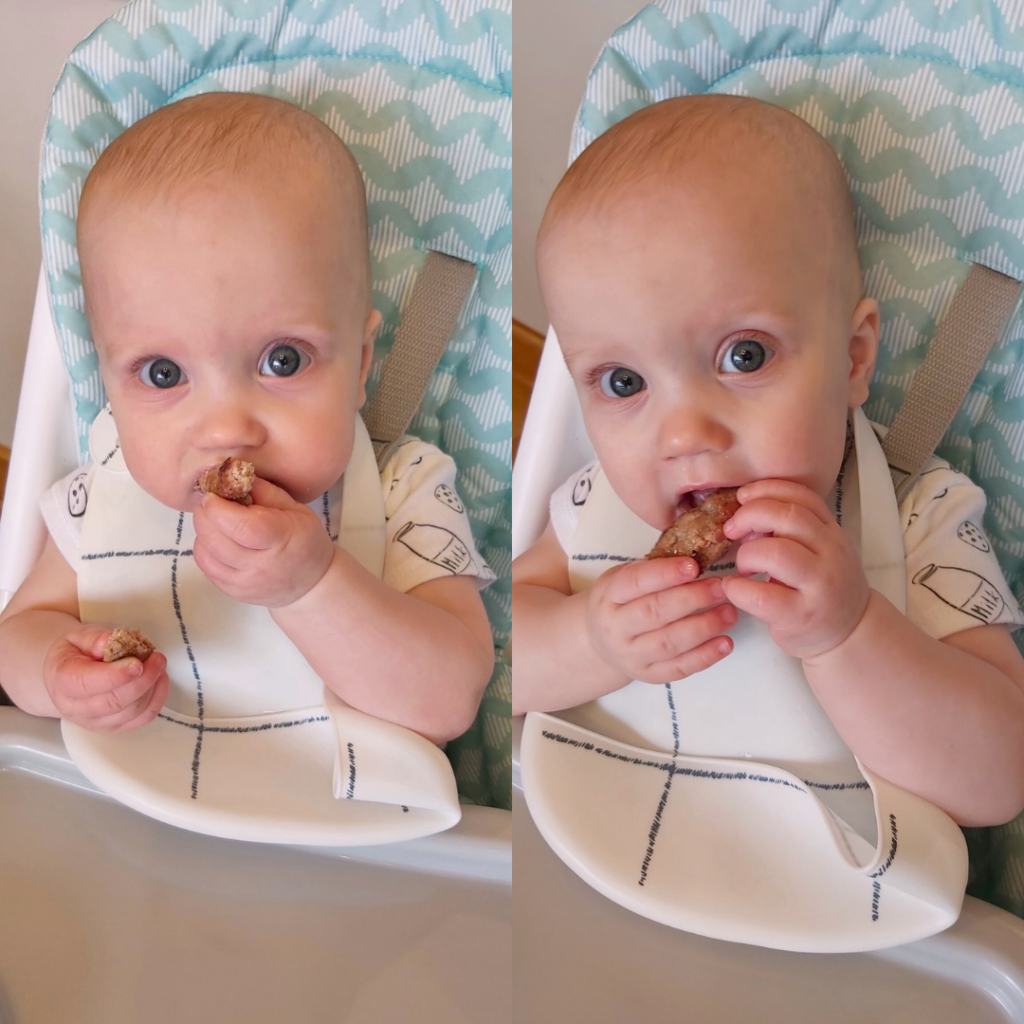
Beef can be introduced as early as 6 months of age. It’s one of the first foods recommended to offer babies as it’s high in iron, protein, and zinc, which are some of the most important nutrients for 6-7 month olds.
In fact, your baby can eat a wide variety of meat at the age of 6 months. However, it’s important to make sure that you know how to serve meat safely to babies because it can be a choking hazard if served incorrectly. You can learn more about serving meat to babies and toddlers, here.
The importance of iron for babies
So why is iron so important at 6 months?
Well, babies are born with iron stores to sustain them until around 6 months of age, but after that point, their iron stores begin to deplete. The introduction of solids that are high in iron around the 6 month mark will help make up for this and prevent iron deficiency. AKA the number one nutrient deficiency among kids in the world!

You can also boost your baby’s iron absorption by adding a source of vitamin C to the meal. One example is to offer ground beef in a tomato-based sauce.
Often, we first think of infant cereal as being one of the best iron sources, but it’s actually fortified with non-heme iron (which isn’t easily absorbed in the body). The type of iron found in beef is heme-iron, and that is actually the most easily absorbed in your body.
So while beef isn’t the only source of iron for your baby, it’s definitely one of the easiest and most iron-rich sources you can provide. Check out my blog on the importance of iron and learn more about why we want to offer high iron foods twice a day to babies, here.
Is ground beef healthy for babies?

Without a doubt, ground beef is a nutritious addition to your baby’s diet! Ground beef offers essential nutrients like iron, B vitamins, zinc, and selenium which promote growth and development. It’s also packed with protein and healthy fats (saturated and polyunsaturated fats) that are beneficial for your baby’s heart and brain.
Now, you’ve probably already googled “Is red meat good or bad?” and found that every other news article and website has conflicting information about why red meat should, or shouldn’t, be part of your diet. So let me clear this up for you now.
There is clear evidence that processed red meat consumption can lead to health concerns like cancer, heart disease, and type 2 diabetes (1).
Just so we’re all on the same page, processed meat includes any type of meat that has gone through processing like salting, smoking, curing, and/or the addition of chemical preservatives, like nitrates/nitrites, to extend the shelf life of the product. This includes things like hot dogs, bologna, pepperoni, deli meats, bacon, jerky, and commercial sausage.
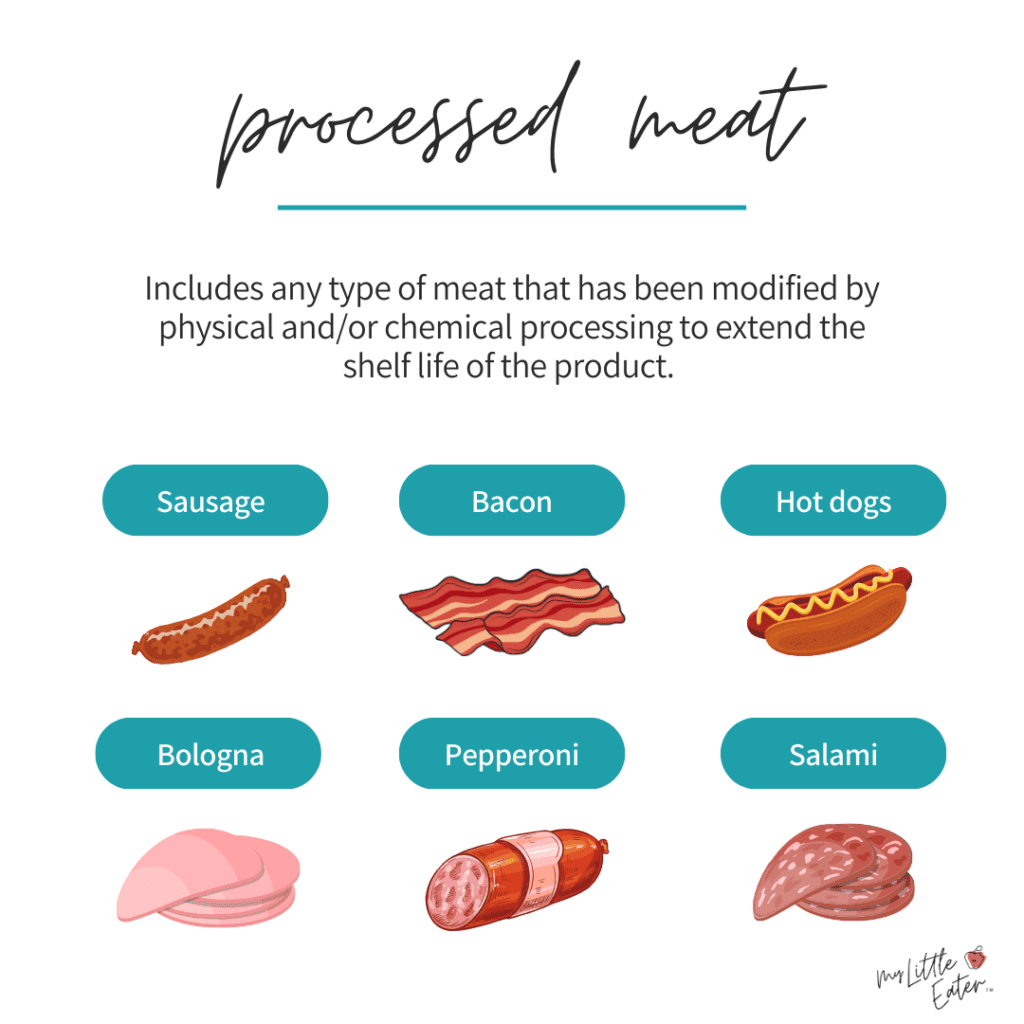
When meat is preserved this way, carcinogenic substances can form, which is why processed meat is not recommended. For this reason, processed meats shouldn’t be offered to babies, with the exception of special occasions. For example, if you’re at a birthday party, or sitting around a campfire – it would be okay to eat a hot dog, as long as it isn’t being served regularly.
On the other hand, red meat in general includes fresh lamb, beef, pork, and veal, which hasn’t gone through additional processing to change the nutritional composition of the meat. To date, there’s no concrete evidence, or thoroughly conducted studies, that identified unprocessed, good-quality red meat as causing any harm (1).
In fact, there are many flaws with the research that say red meat is likely harmful. For example, they aren’t looking at a group of only healthy people. They’re looking at people with other lifestyle factors that could be resulting in harmful outcomes, like smoking, alcohol consumption, and not enough physical activity. Red meat may or may not be the cause but it’s hard to know if these factors aren’t eliminated. This also makes it extremely difficult for researchers to form concrete recommendations as to how often red meat should be consumed.
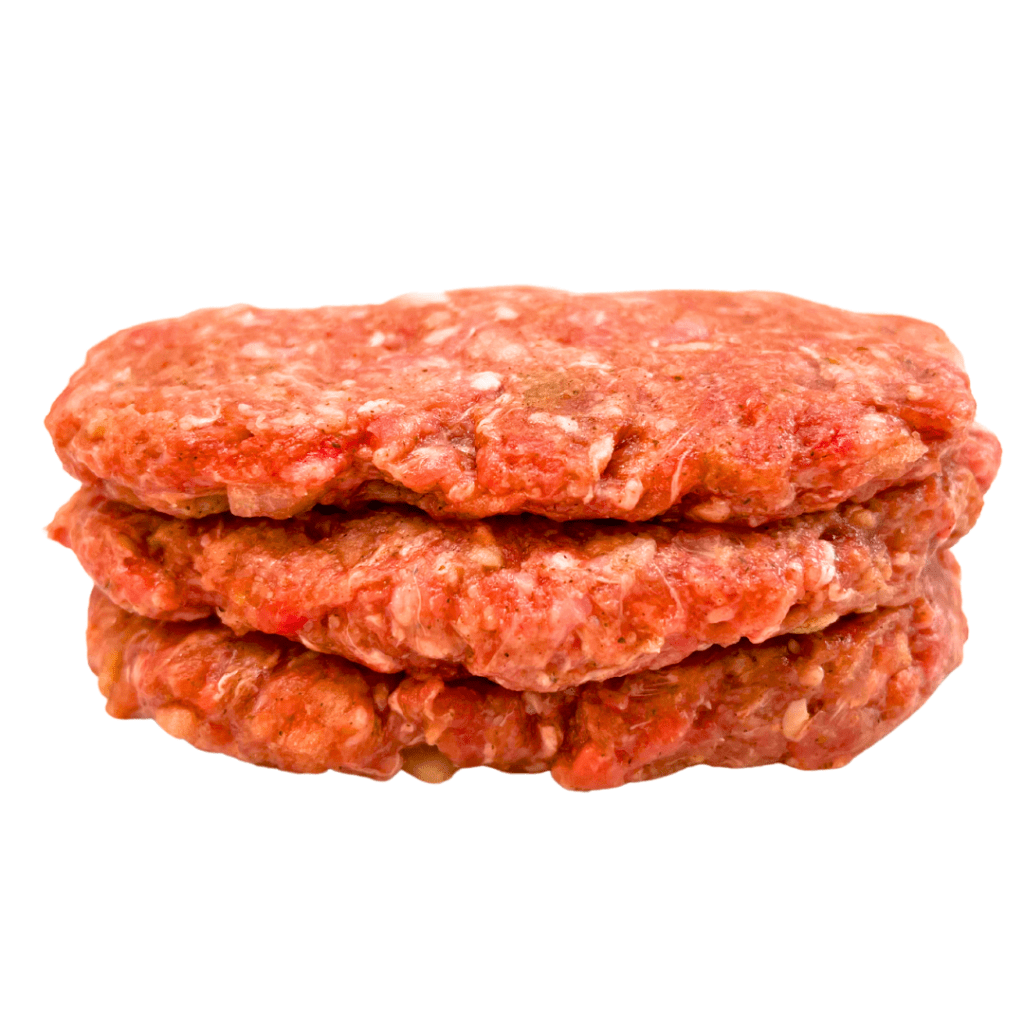
So you see how that information could be confusing and lead to misinterpretation? More research is needed to determine the effects of red meat consumption, and on strategies to reduce these effects by improving the composition, processing, and household cooking of the meat. Even more importantly, it’s believed that the interaction of meat with other foods in dietary patterns should be investigated (1,3).
The bottom line is that red meat, including ground beef, is not harmful and is a nutritionally dense option for beefing up your baby’s iron intake. Whereas, processed meat can have negative impacts on our health, and we don’t recommend serving it except for a rare occasion.
How often should babies have ground beef?
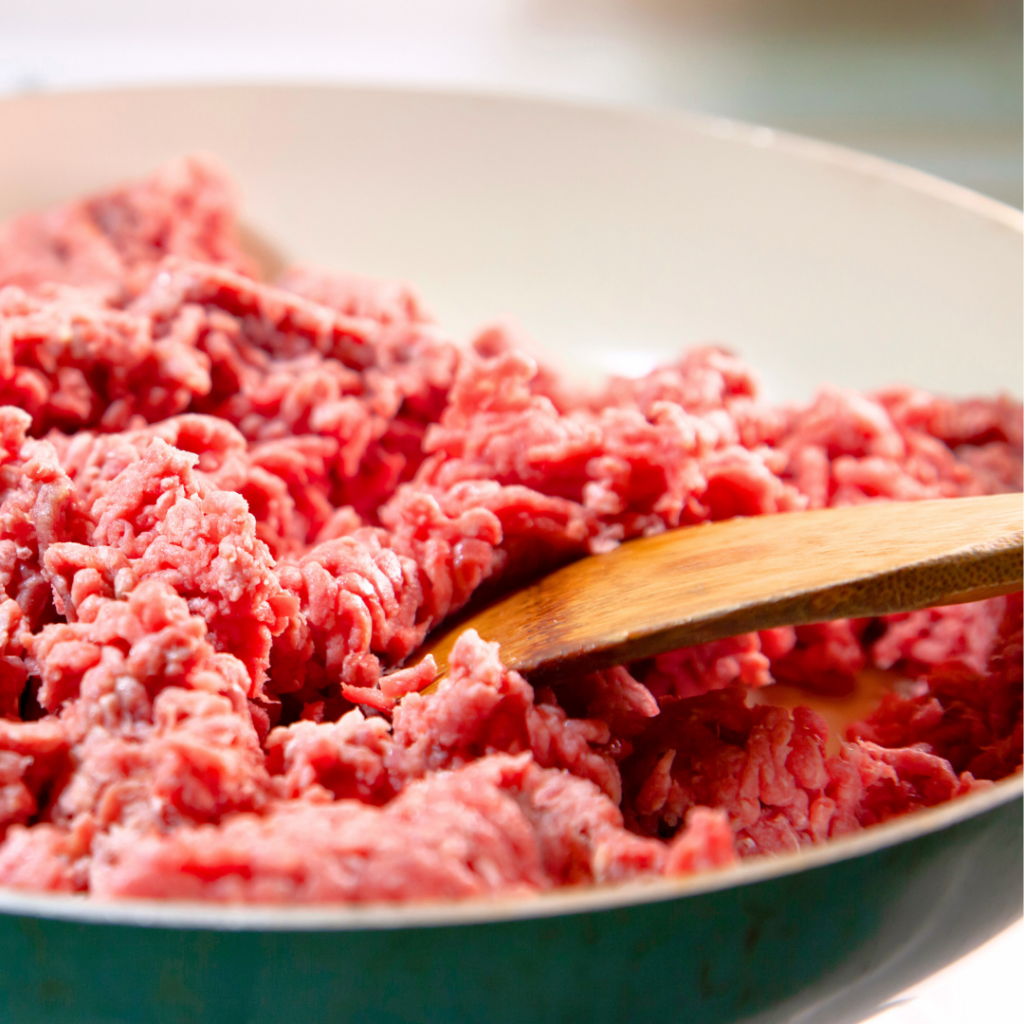
Fresh red meat can be offered to babies regularly as it provides many essential vitamins and minerals. Serving it once a day would be acceptable, although a few times a week is more realistic. This would allow you to still offer baby a wide variety of different tastes and textures from other meat, or meat alternative sources.
What’s important is that between 6 and 12 months, babies should be offered iron-rich foods two or more times a day. From 12 to 24 months of age, iron-rich foods should be offered at each meal.
Now, iron-rich foods don’t always have to be animal meat, but animal-based products are typically higher in iron and provide other essential nutrients for growth and development. As they grow, I recommend offering older infants meat, fish, poultry, or meat alternatives, at least once per day.
What kind of ground beef is best for baby?
Now that I’ve explained why ground beef is recommended, you may be wondering what type of ground beef is best for your baby. When it comes to choosing the best type of ground beef for your baby, it doesn’t have to be too complicated. As long as it’s fresh ground beef, meaning it’s not pre-seasoned or marinated, you can choose whatever one fits in the budget.
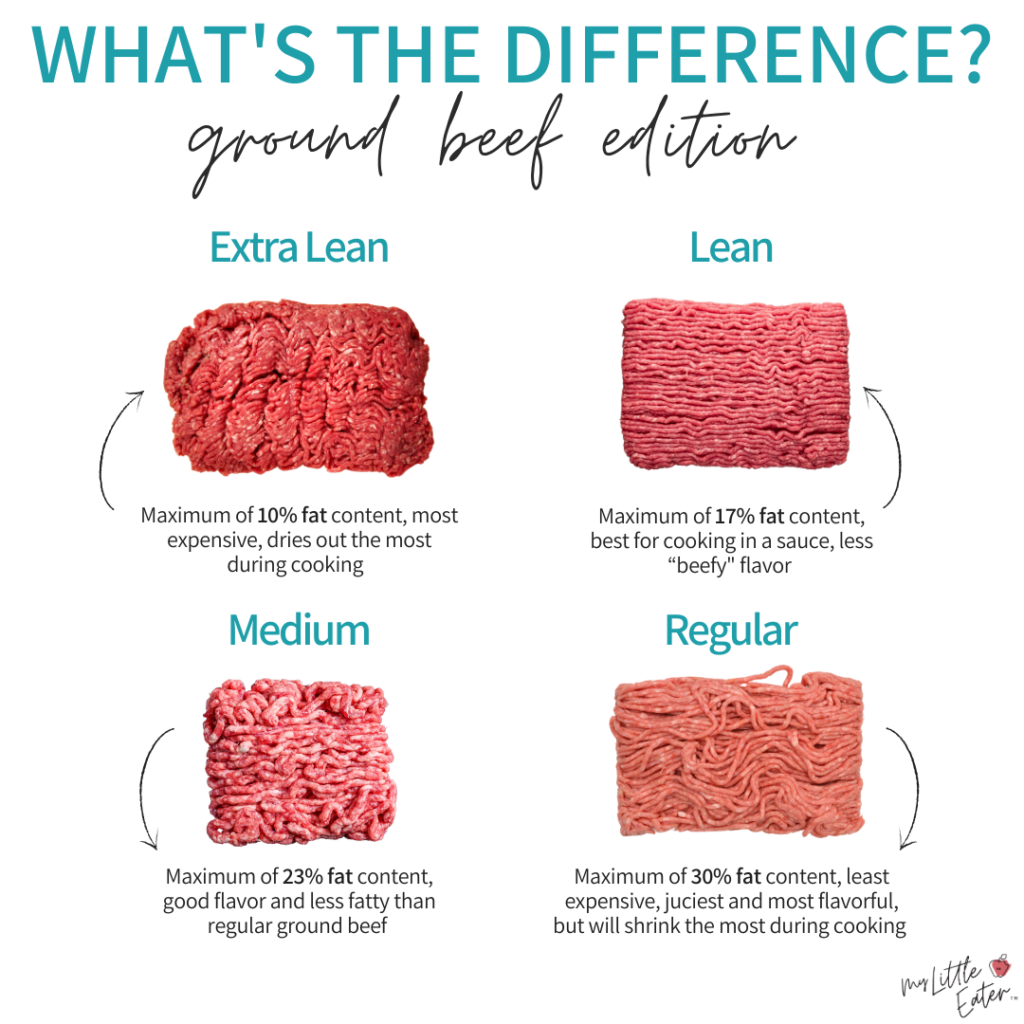
As you may already know, there are 4 different options of ground beef for baby led weaning – regular, medium, lean, and extra lean. Regular ground beef has the highest fat content, which also means it’s the cheapest option. The opposite is true for extra lean ground beef, as it has the lowest fat content and the highest price tag.
I would actually recommend choosing regular or medium ground beef versus lean or extra lean. This might be surprising, but because medium and regular ground beef is juicier, this makes it safer for your baby to eat. And, they have a higher fat content that will provide your baby or toddler with more calories, which is beneficial for their growth.

Quick Tip: A good way to tell if ground beef will be juicy and easy for your baby to chew is to look for white marbling lines. These white lines are fat. The more white marbling, the more juicy the meat will be (as long as you don’t get rid of the fat during the cooking process).
What about organic and grass-fed beef?
If you can afford it, and you prefer to buy grass-fed, organic ground beef, that’s ideal! The nutritional benefits of choosing grass-fed, organic meat are: a superior fat profile, less cholesterol, and more antioxidants compared to conventional meat (4). Organic, grass-fed meat has a higher concentration of polyunsaturated fatty acids (needed for brain function and cell growth) and beneficial omega-3 fatty acids (beneficial for heart health), if you want to get technical (4). We have a blog all about organic foods if you want to learn more.
But, for those on a tighter budget, it’s totally acceptable to buy regular ground beef. What’s most important is that you’re offering ground beef to meet your baby’s high iron requirements.
Is ground beef a choking hazard for babies?
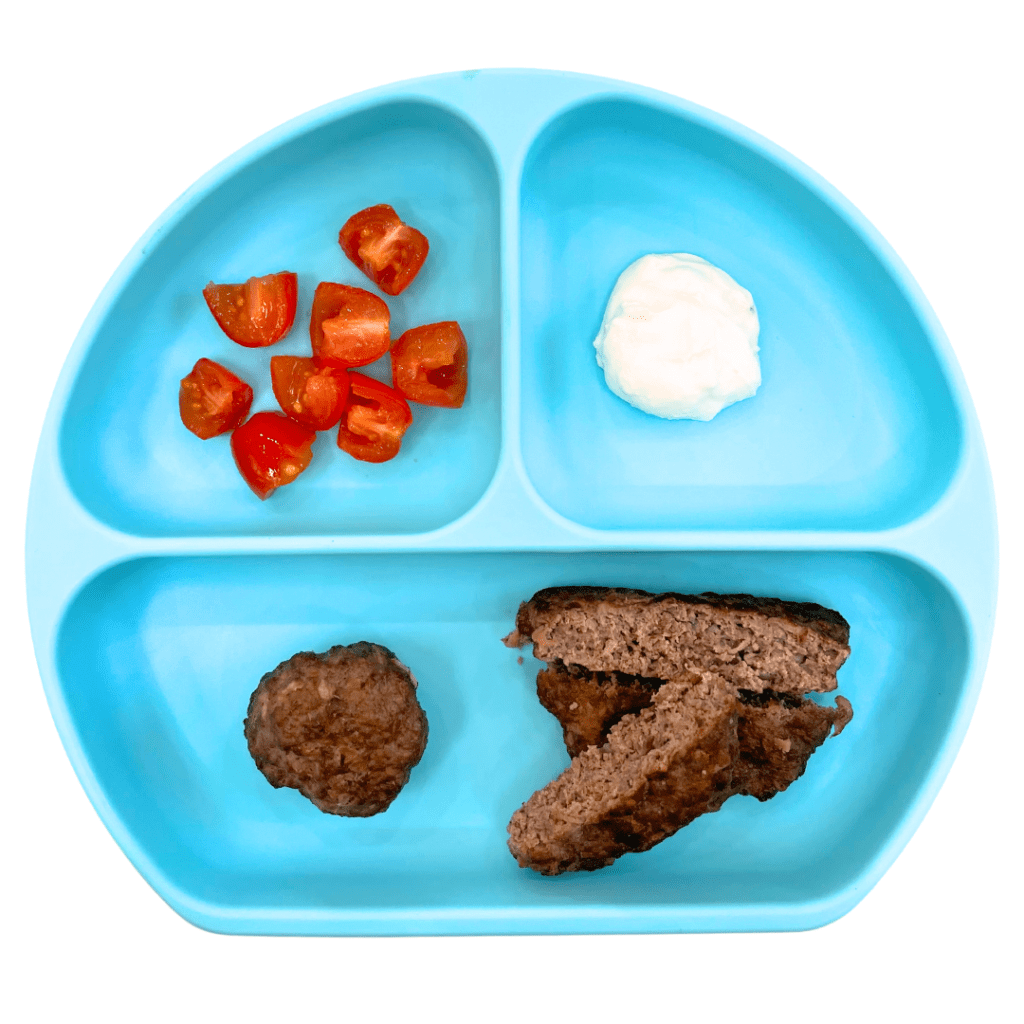
Many parents probably associate meat with being a choking hazard for babies and toddlers because of the toughness, and in some cases, dry texture.
Technically, ground beef isn’t on the choking hazards list, but it can be a bit riskier if it’s not offered to your baby in the proper form based on their age. When served properly, ground beef is softer than cubed beef, strips of steak, or even chicken breast, and can be easily manipulated by your baby’s gums.
Keeping ground beef, and any other type of meat for that matter, moist and tender is the best way to safely serve it to your baby. Check out my blog on how to serve meat to babies/toddlers for more info. It will help build up your confidence and offer some other great tips and tricks for safely serving meat to your baby.
You can also learn more about buying the most tender cuts of meat for baby, if you need help picking the best options at the grocery store.
Tips to keep ground beef moist for babies
Keeping meat moist makes it much easier for your baby or toddler to eat and swallow (and the recipe shared below is an excellent example!).
In general, adding lots of milk to the raw mixture will keep burgers moist and juicy for your baby. Adding breadcrumbs to the raw mixture also helps absorb liquid and keep meat from getting dry during cooking. Avoid pressing the patties with a spatula as they cook—that just forces out the juice. Use the spatula strictly for flipping. And of course, overcooking the meat will cause it to dry out.
If the meat is a bit dry after cooking, or you want to be extra safe, please feel free to add a sauce or dip on top of the burger to make it easier for your baby to manage in their mouth! Examples include tomato sauce, plain regular or Greek yogurt, pesto, guacamole, and applesauce. You can also just mix them right in with the meat if serving the ground beef broken down into pieces.
Safely preparing ground beef for babies 6 - 18 months

Believe it or not, ground beef can be offered as both a puréed baby food and a finger food. So regardless of how you’re choosing to start your baby led feeding journey, you can serve your baby ground beef and get all of the nutritional benefits for them!
How to serve ground beef as a purée (6 months plus)
If you’re starting your feeding journey by offering purées, here’s how to prep it.
Add fully cooked pieces of ground beef to a blender or food processor. Then add a small amount of liquid, like breastmilk or formula, to create a smooth texture. You can even add in some spices, like oregano or thyme, for additional flavor exposure.
Preload a baby spoon with the beef mixture and let your baby take the lead, or spoon-feed your baby the baby led way (something I teach in my online course!). I’ve also made a guide on how to teach utensil use and listed my favorite baby spoons for self-feeding purées – check it out here!

If you’ve moved on from smooth purées to a more advanced phase of my signature Texture Timeline™, such as a lumpy purée, ground beef can be offered for this phase as well. Think of the ground beef as the “lumps”!
Mix the ground beef with mashed vegetables like carrots, turnip, potato, sweet potato, etc. Then spoon-feed your baby, or load it on a preloaded spoon, like the Num-num Gootensil. Another safe option is to offer ground beef in sauces (like spaghetti sauce) and serve over mashed potatoes or spaghetti noodles. You can do the same with chili too…the possibilities are endless!
To learn more about this gradual process of progressing in textures using my Texture Timeline™, check out our Baby Led Feeding online course! It provides all the details you need including examples of foods in each phase, and a searchable food video library showing foods at different phases of the Texture Timeline™.
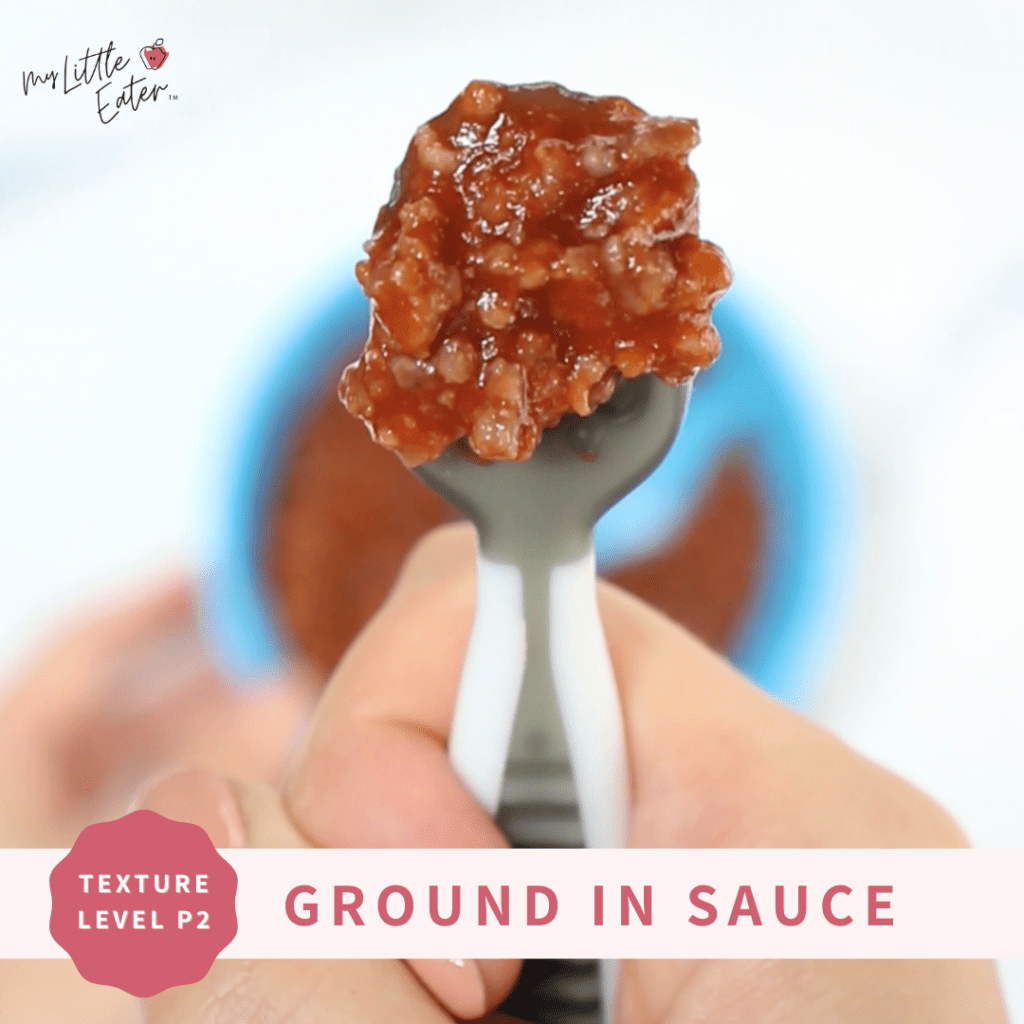
As I mentioned before, you can also spice things up by adding seasonings to expose your baby to new flavors…and honestly make it taste better! It’s so much more palatable when there are undertones of herby flavors to balance out the taste of the meat.
I encourage you to be creative and adventurous when adding herbs and spices to your baby’s food. Be sure to check out my blog on why you need to add spices to your baby’s food for all the nitty gritty details!
How to serve beef as a finger food (6 months plus)
Doing baby led weaning with ground beef is also possible. In the beginning stages of baby led weaning, the main objective is to prepare food in a way that your baby can easily get the food up to their mouth. This is because babies only have their palmar grasp at around 6 months of age, and so can’t pick up tiny pieces of ground beef because that would require their pincer grasp, which develops later.
You can offer beef burgers in strips, to make it easy for baby to pick up and hold. You’ll want to cut the burger into finger-length strips, and ensure it’s very moist before serving (add those dips and spreads if you aren’t sure!). This option will allow baby to suck and remove the iron-rich juices from the ground beef. The burger recipe included below has added milk and apples, keeping it extra moist during the cooking process.
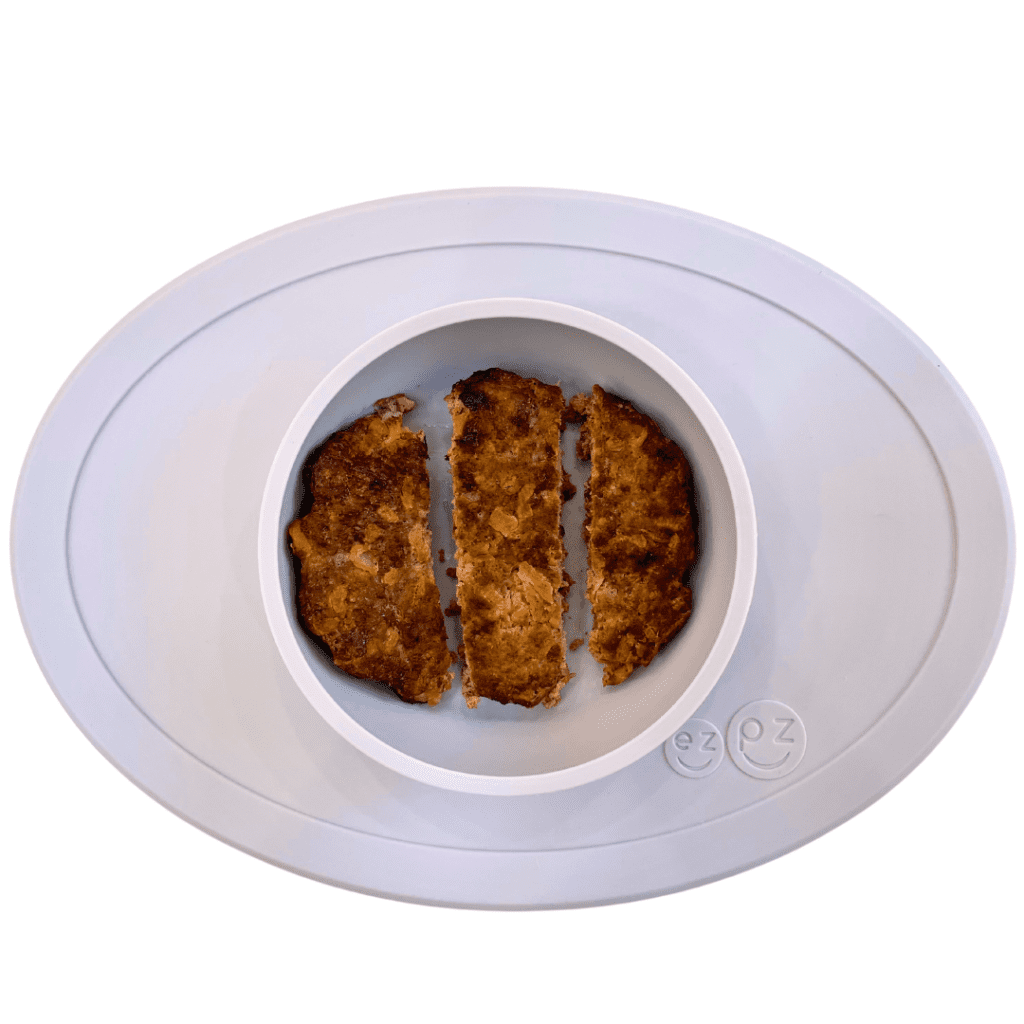
You can also try offering this recipe as a whole baby-sized meatball, as long as it’s very moist on both the inside and outside. Going bigger with the size is usually easier for babies to hold. They’ll be able to take bites out of a larger meatball, and yes, it will crumble and break into smaller pieces, but it’s all about exploring and figuring things out at this age, so that’s okay!
If you’re looking for inspiration for meals that are baby-friendly and that will be loved by the whole family, check out our 60 Day Baby Meal Plan! It was also recently redone to include grocery lists, new feeding tips, and more!
Finally, it’s also safe to offer ground beef in the form of a casserole or shepherd’s pie-type dish before 9 months. Simply preload it on a spoon or let them go at it with their hands!
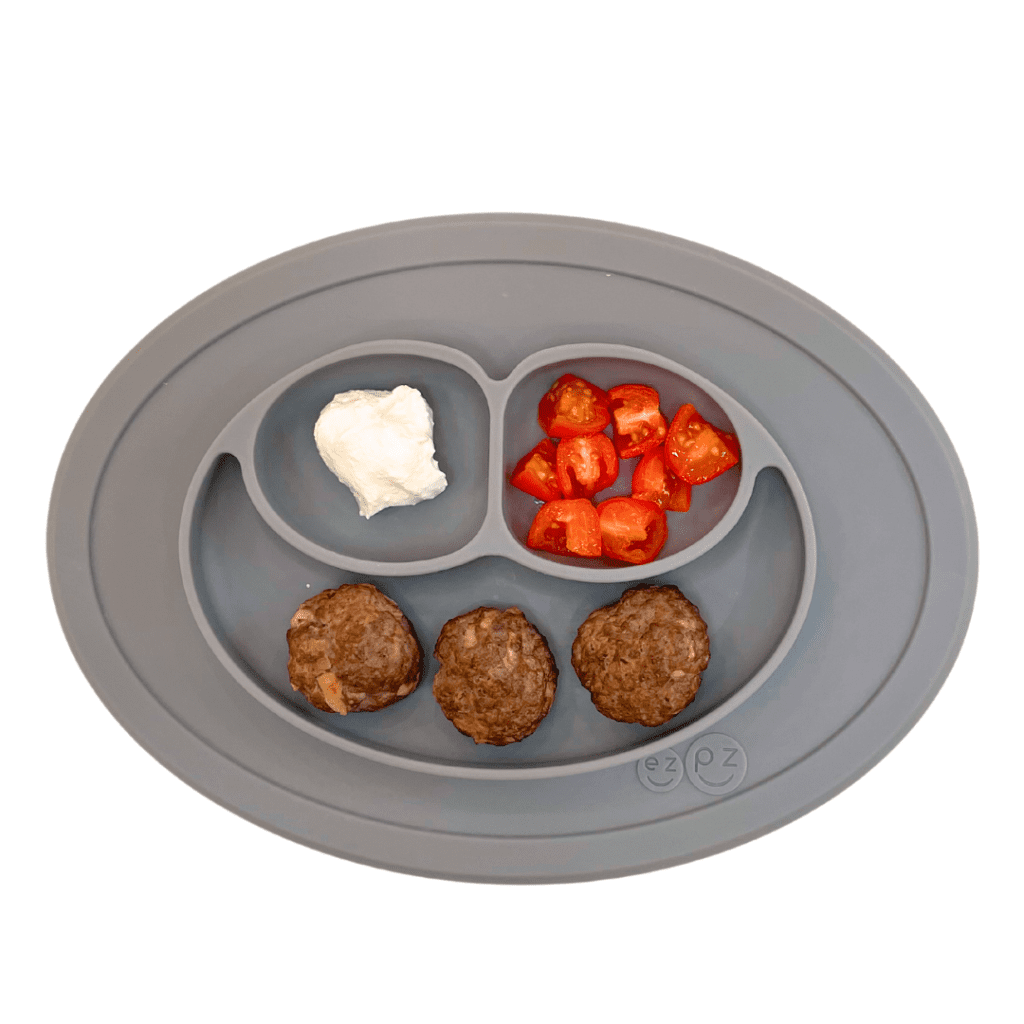
You can continue to serve whole strips of meat until your baby has the ability to bite and pick up smaller pieces of meat (using their pincer grasp). Your baby may be able to bite down and get a large chunk of meat in their mouth, which can be frightening! I assure you that the texture of the ground beef (when not dried out) is soft enough that they can squish it between their gums, allowing it to crumble into much smaller pieces.
If a large piece does get to the back of their mouth, that strong gag reflex will kick in to bring it to the front of the mouth again to chew some more, or spit it out! This will teach them how to take bites and figure out how much food can fit in their mouth.
When your baby is 12+ months, you can still offer ground beef patties in strips, or as a meatball, and coach your toddler to take small bites, and chew their food very well. Continue serving them with plain yogurt, applesauce, or other dips (if you’d like) for added moisture and a bit of novelty too.
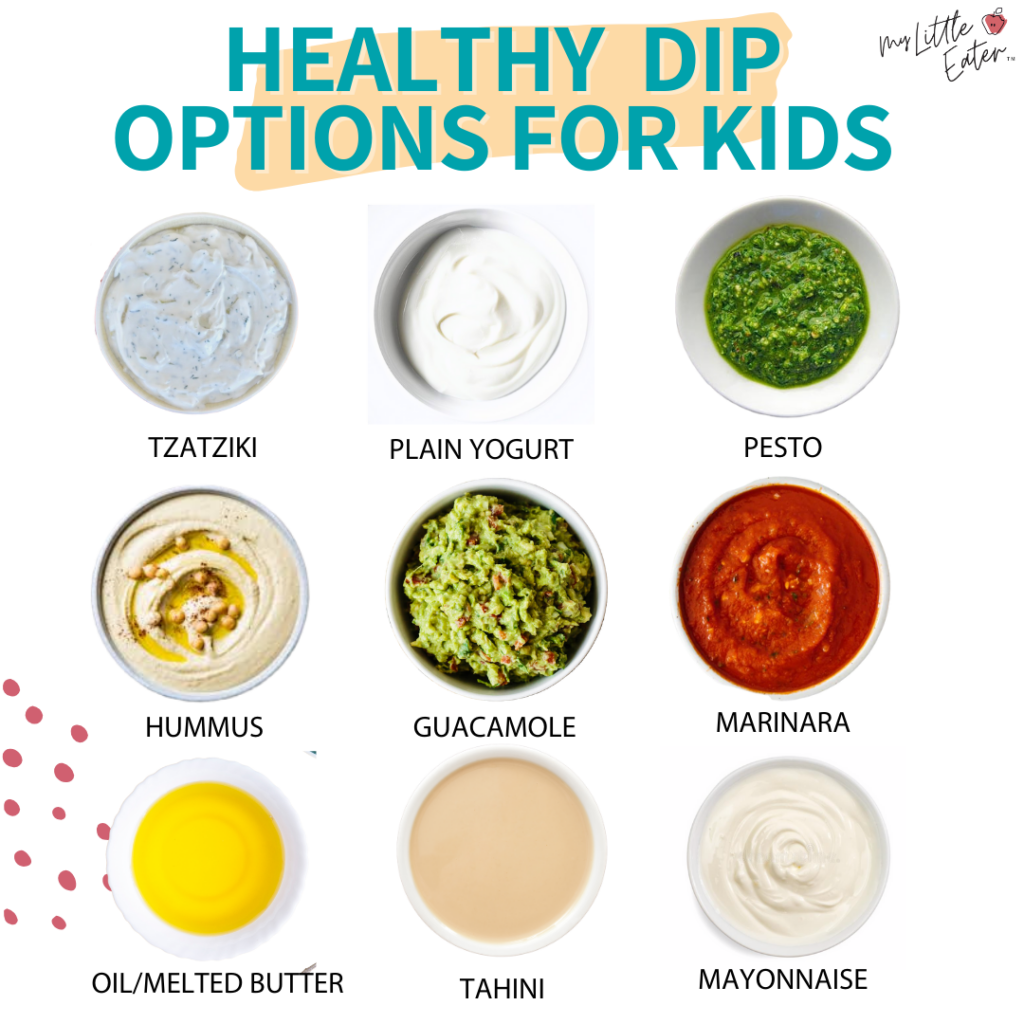
Just remember that in the early stages of baby led weaning the goal isn’t for your baby to eat a whole portion of meat. They have small tummies and are getting most of their nutrients from breast milk or formula. The most important things are that they’re practicing how to get the food to their mouth, how to hold it in their hands, and they’re exploring different tastes and textures.
If you’re concerned about how much your baby should be eating, check out our free portion guide for babies for all you need to know!
Safely preparing ground beef for toddlers (18 months plus)
At this age, your toddler may be ready to eat a hamburger on a bun. Some toddlers might want to disassemble the burger and eat it that way, others might eat it like a regular hamburger.
Either way is acceptable!
We suggest cutting it in half, or even quarters, to make it easier for your toddler to pick up since it will be bulkier than what they’re probably used to eating.
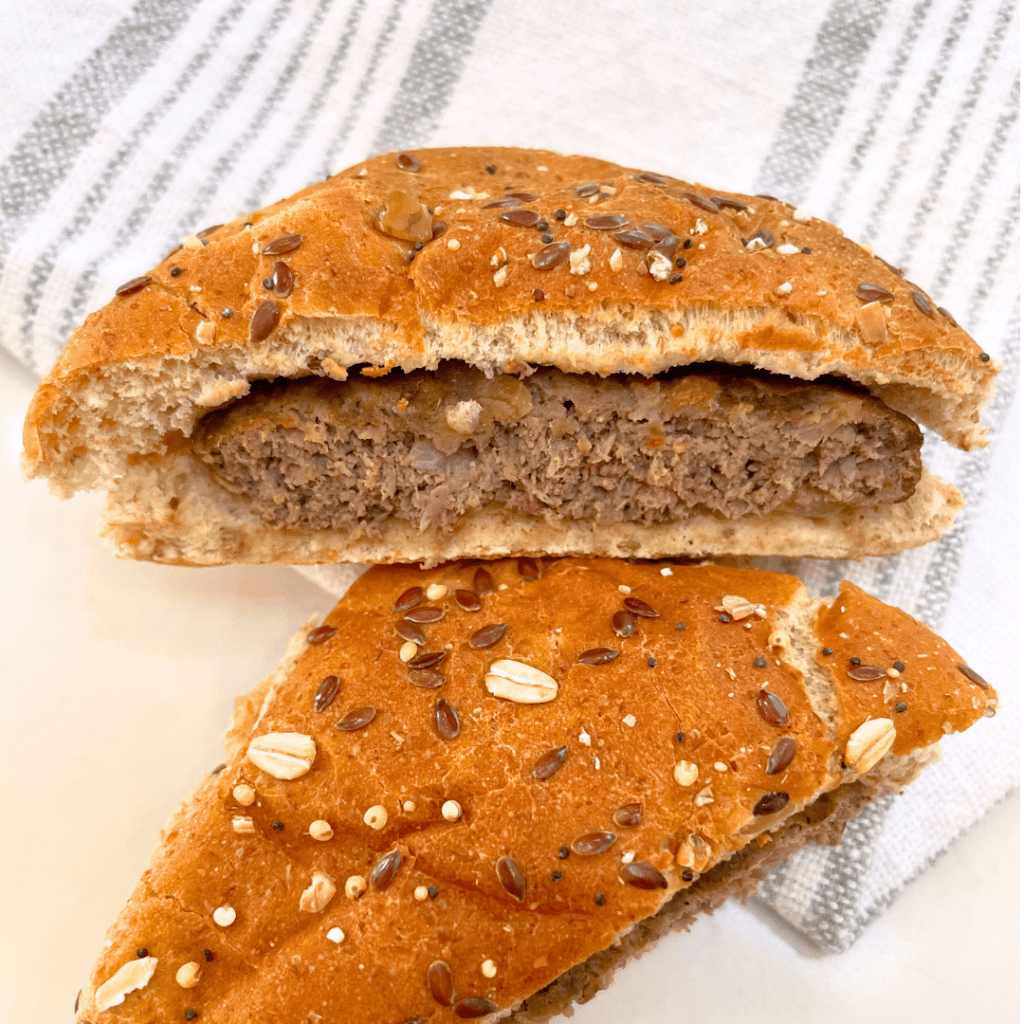
Picky Toddler Tip: Offer your toddler an apple sage meatball, instead of a burger, and add their favorite dipping sauce as a side. Encourage them to pick up the meatball with a toddler friendly food pick and take their animal for a swim in their favorite dipping sauce! For more food play ideas for picky toddlers and to help manage or prevent picky eating, check out our feeding toddlers course!
How to cook ground beef for baby led weaning
One of the most important things you should know when preparing ground beef for your baby is that it should be fully cooked to at least 160°F. There should be no pink remaining once the ground beef is done cooking. Cooking ground beef for babies can be done any way you like, such as in the oven, on the stovetop, or on the grill, as long as it’s fully cooked.

We know you may have questions or concerns about giving your baby food off the grill. High-temperature cooking methods like frying, smoking, grilling, or charring can lead to the production of chemicals like heterocyclic amines (HCAs) and polycyclic aromatic hydrocarbons (PAHs) (5).
Studies have shown that exposure to HCAs and PAHs can cause cancer in rodents. However, the doses of HCAs and PAHs used in these studies were VERY high—equivalent to thousands of times the doses that a person would consume in a normal diet (5). So it’s totally fine when not offered all the time, I promise.
That being said, slower cooking methods are safer for baby and should be the primary method of preparation.
Slow cooking methods include baking, roasting, poaching, and stewing, which will also keep the meat nice and juicy, making it safer for baby to eat and easier to squish and chew between their gums.
If you want to learn more, check out our blog on BBQ food and your baby.
Let’s fire up the grill (or oven)!
This super simple recipe has only six basic ingredients that you probably already have at home. These burgers are so flavorful and juicy that you have to give them a try and let us know what you think of them!
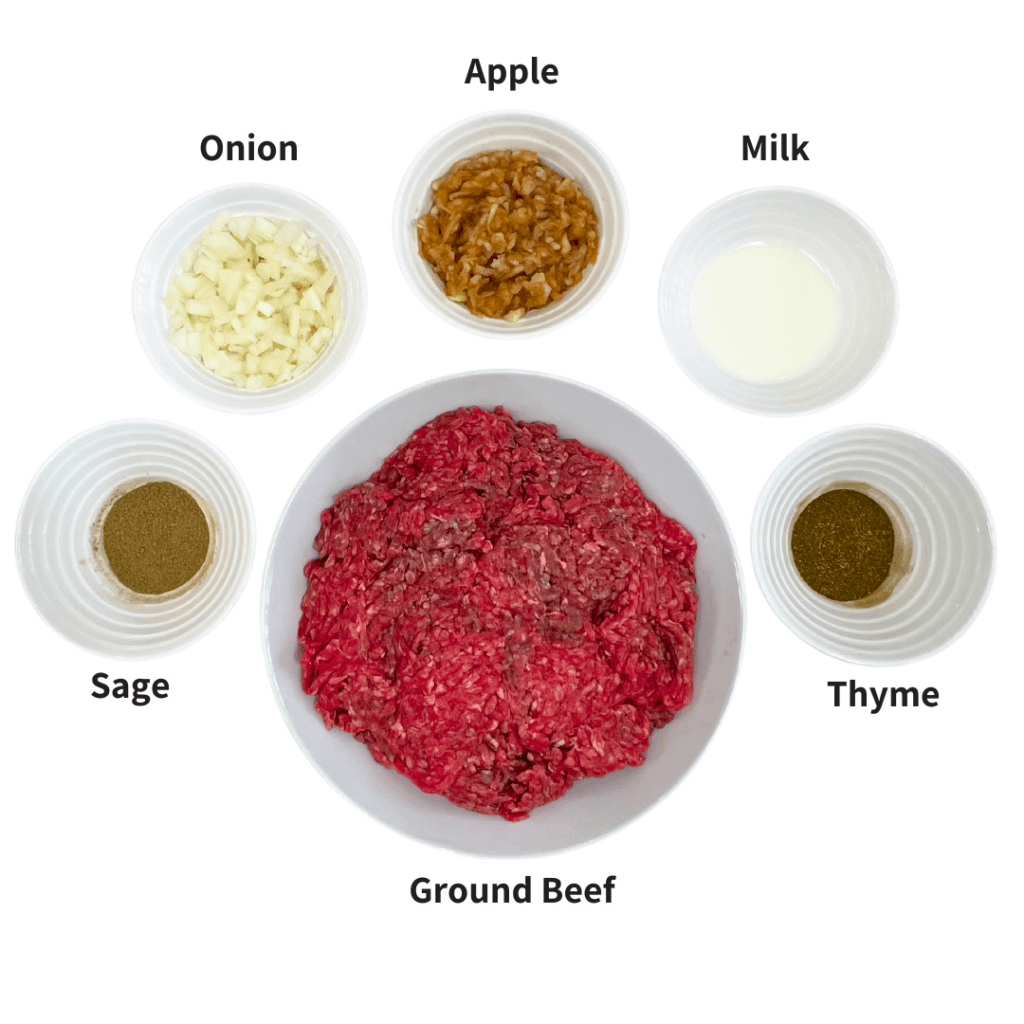
Step one:
After preparing all of your ingredients, start by preheating your oven to 400°F. You can also cook these burgers on the BBQ. Since every barbecue is different, I would recommend cooking your burgers until they reach an internal temperature of 160°F (71°C).
Step two:
Grab a large bowl and add all six ingredients. You want to make sure everything is well incorporated, so give your hands a good wash and get right into the mixture! You’ll need to use your hands to form the patties (or meatballs) so instead of dirtying another utensil, you can just mix it together using your hands!
Once your toddler is older, and you know they won’t try to eat or lick the raw meat off their hands, this is a great sensory task for them to help you with in the kitchen!
Step three:
Form the mixture into patties, about ½ inch thick, and at least 4 inches wide. They’ll shrink as they cook, so make sure they’re big enough so you don’t end up with mini hamburgers!
Step four:
If you’re baking them in the oven, line a baking sheet with parchment paper and bake for approximately 20 minutes, or until they’re completely cooked through. You can flip the burgers after about 10 minutes so they’ll cook evenly on both sides.
If cooking on the barbeque, adjust the cooking time accordingly to reach an internal temperature of 160°F.
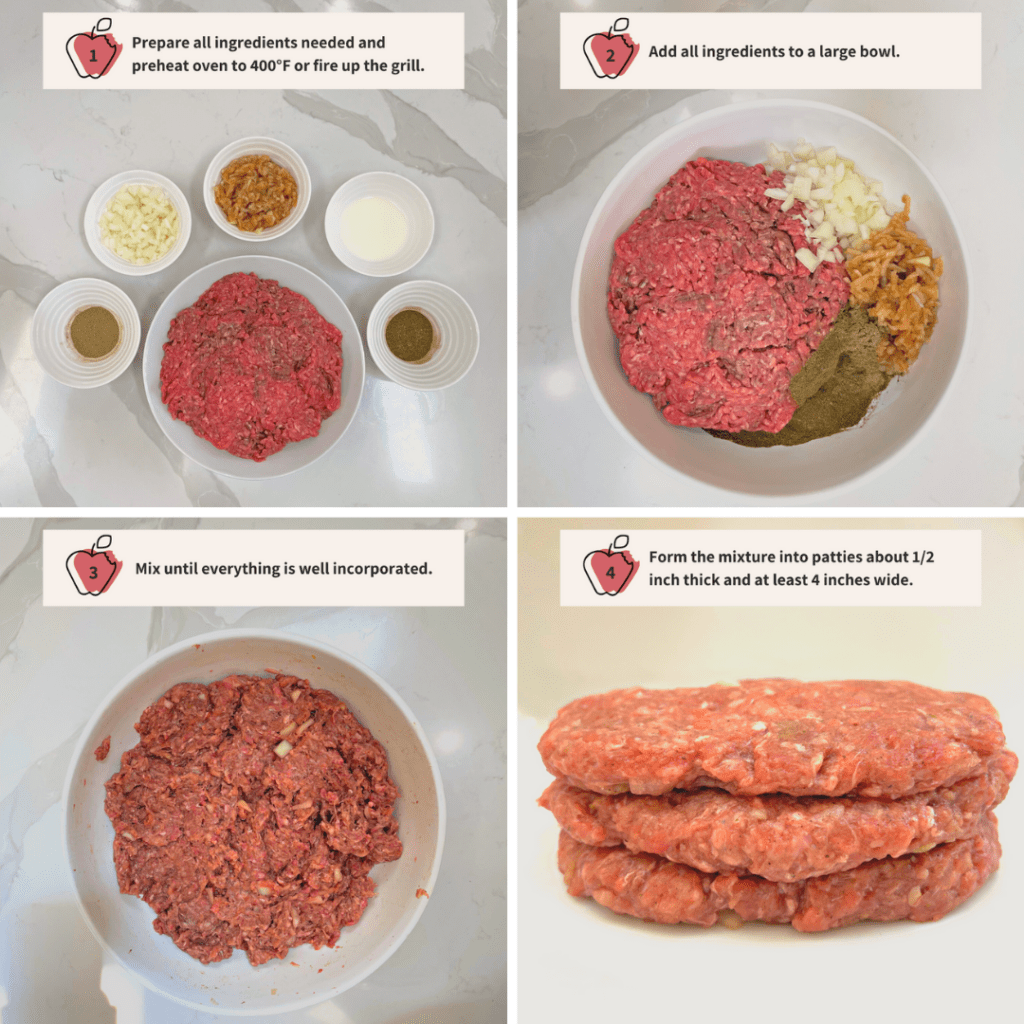
Step five:
You can serve your baby whole patties, or cut them into strips. Be sure to keep every piece of hamburger moist by adding dips, spreads, or sauces, as discussed above.
The whole family will enjoy this recipe, so there probably won’t be any leftovers, but if there are, you can refrigerate them in an air-tight container for up to 5 days.

Remember to check out my 60 Day Baby Led Feeding Meal Plan – you’ll get access to over 80 recipes that are perfect for starting solids, and that the whole family can enjoy. This isn’t just a regular meal plan with a list of recipes, you’ll actually be able to follow along with the plan to strategically introduce allergens, advance your baby in textures, and ensure all nutrient needs are being met.
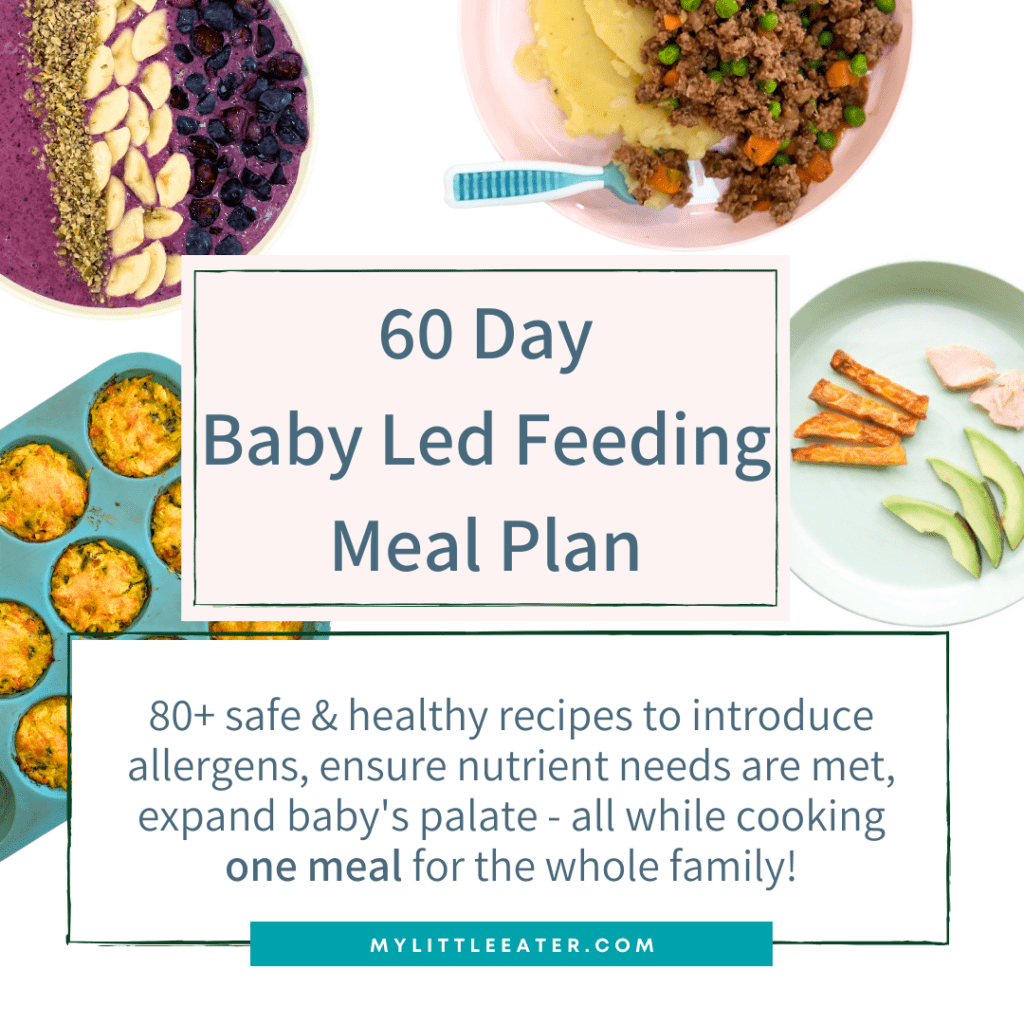
In the meal plan you’ll get lots of great beef, turkey and other meat recipes for baby led feeding, like:
- Shepherd’s pie bowls
- Slow cooked lamb with apples
- Sesame ginger salmon
- Slow cooker turkey swedish meatballs
- And so many more!
Ground beef FAQ
It’s acceptable to offer your baby red meat daily, but we recommend offering it a few times a week (3-4) so baby has the opportunity for exposure to other types of meat and meat alternatives. Processed meats should be avoided for babies and toddlers, with the exception of special occasions.
It actually doesn’t matter if it’s regular ground beef, grass-fed, or organic (although grass-fed and organic will have a better fat profile, but it’s not a big deal if your budget doesn’t allow for it). Any type is acceptable, as long as the ground beef isn’t pre-seasoned, because it’s almost guaranteed to contain a high amount of salt, which you’ll want to avoid.
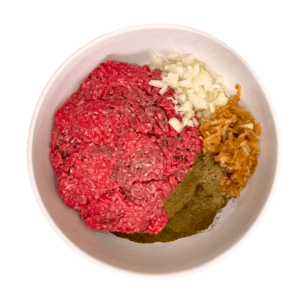
You can season your ground beef for baby right from the beginning, giving baby lots of taste exposure is recommended right from the start. Flavors like onion, cumin, paprika, rosemary, sage, and thyme all pair very well with ground beef. Be mindful of added salt in certain seasonings, check the ingredients list, and avoid seasonings with high amounts of sodium.
Ground beef should be fully cooked to 160°F. There should be no pink remaining once it’s done cooking. Any way of cooking is acceptable, you can cook it in the oven, on the barbeque, or on the stovetop.
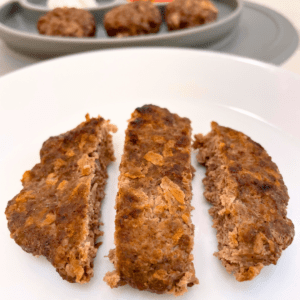
As a finger food, you’ll want to cut the ground beef patty in finger-length strips so it’s easy for your baby to pick up and hold. That’s generally at least 1-2” wide and ½” thick.
Ground beef in mixed dishes is totally safe for baby! Whether that be in the form of a bolognese sauce with pasta, or shepherd’s pie. If you want a delicious shepherd’s pie recipe that’s safe for baby, check out my 60 Day Baby Led Feeding Meal Plan.
Love it? pin it to save for later!
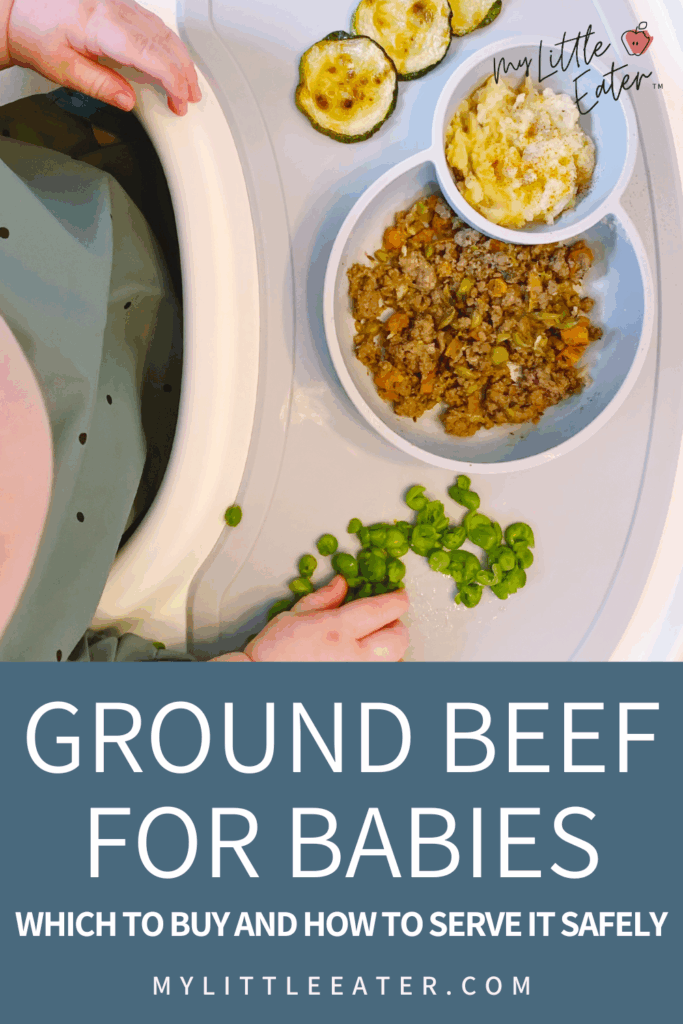
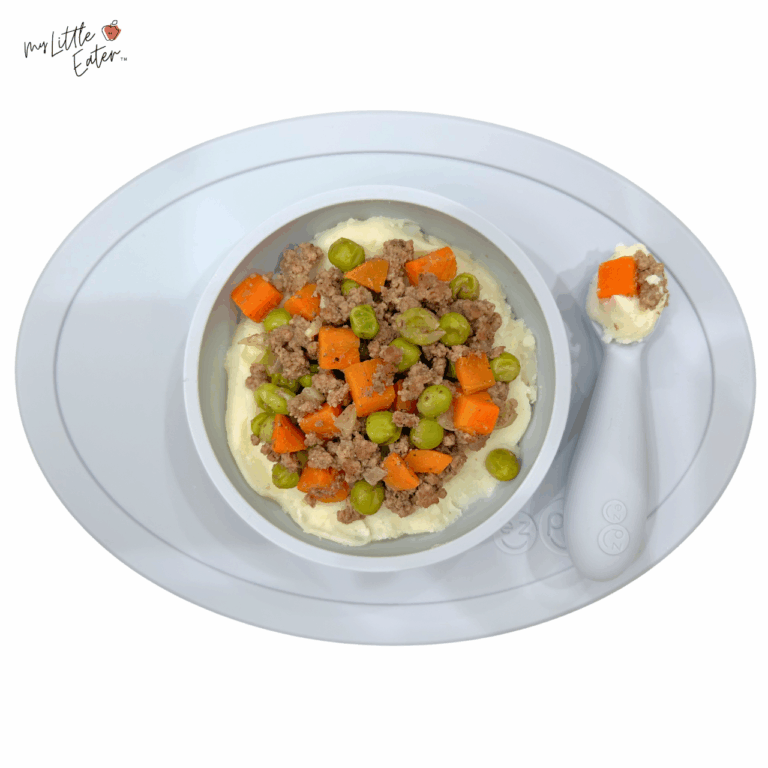
Shepherd's Pie Bowls
Ingredients
- 1 yellow onion
- 2 garlic cloves (or 1/2 tsp garlic powder)
- ¼ cup green onion
- 1 tbsp (15 ml) extra virgin olive oil
- 1 tb (454g or 16 oz) medium ground beef
- 1 cup (135 g) frozen carrots
- 1 cup (152 g) frozen peas
- 1 tsp (2.7 g) black pepper
- t tbsp (3.3 g) dried rosemary
- 1 tbsp (4.4 g) dried thyme
- 1 tbsp (15 ml) Worcestershire sauce (contains anchovies (finned fish))
- ½ cup (120 ml) beef broth (low sodium)
- 2 cups mashed potato
Instructions
- Dice the yellow onion. Mince the garlic cloves. Dice the green onions.
- Heat the oil in a large skillet. Add the yellow onion and minced garlic, and cook 3-4 minutes until fragrant. Add the ground beef, breaking it up in the pan to yield small pieces. Tip: Mash the beef during the cooking process with a potato masher to get smaller, more manageable pieces.
- Add the carrots and peas, black pepper, rosemary, thyme, Worcestershire sauce, and beef broth. Simmer with the lid on for 15-20 minutes, or until veggies are softened and meat has been cooked through.
- Reheat the leftover mashed potatoes from yesterday. Add a splash of warm milk or a couple of tablespoons of warm butter if you need to soften it up again and make it more creamy and moist.
Video
Notes
References:
- De Smet, S., & Vossen, E. Meat: The balance between nutrition and health. A review. Meat Science, 120, 145-156 (2016).
- De Smet, S., & Vossen, E. Meat: The balance between nutrition and health. A review. Meat Science, 120, 145-156 (2016).
- Schönfeldt, H. C., & Hall, N. G. Consumer education on the health benefits of red meat—A multidisciplinary approach. Food Research International, 47(2), 152-155 (2012).
- https://www.organic-center.org/sites/default/files/publication_files/meatstudy-final_05_14_0.pdf
- https://www.cancer.gov/about-cancer/causes-prevention/risk/diet/cooked-meats-fact-sheet

ABOUT THE AUTHOR
EDWENA KENNEDY, RD
Founder and lead Registered Pediatric Dietitian at My Little Eater Inc., creator of The Texture Timeline™, and mom of two picky-turned-adventurous eaters.

ABOUT THE AUTHOR
EDWENA KENNEDY, RD
Founder and lead Registered Pediatric Dietitian at My Little Eater Inc., creator of The Texture Timeline™, and mom of two picky-turned-adventurous eaters.

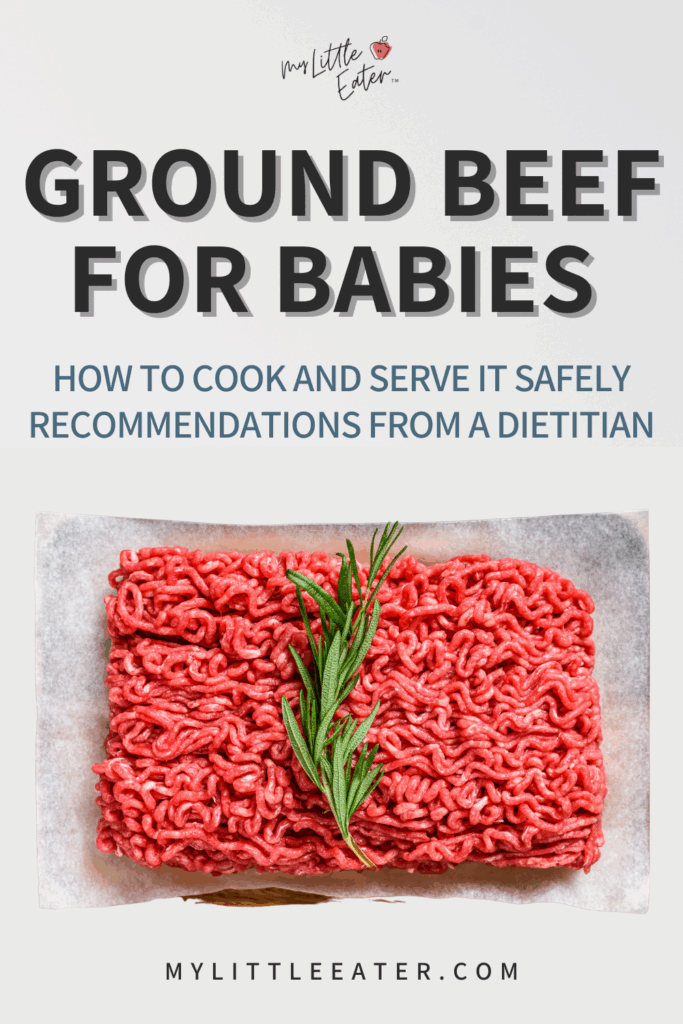

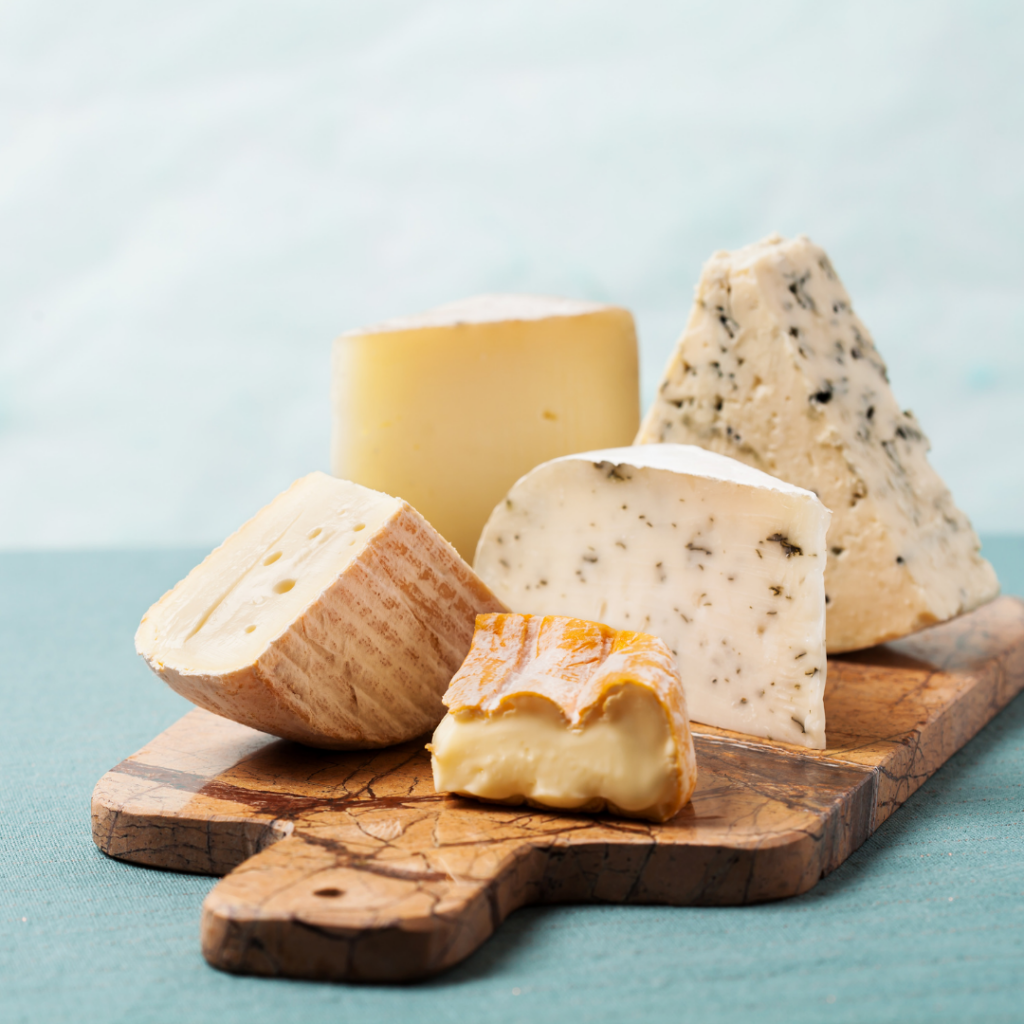
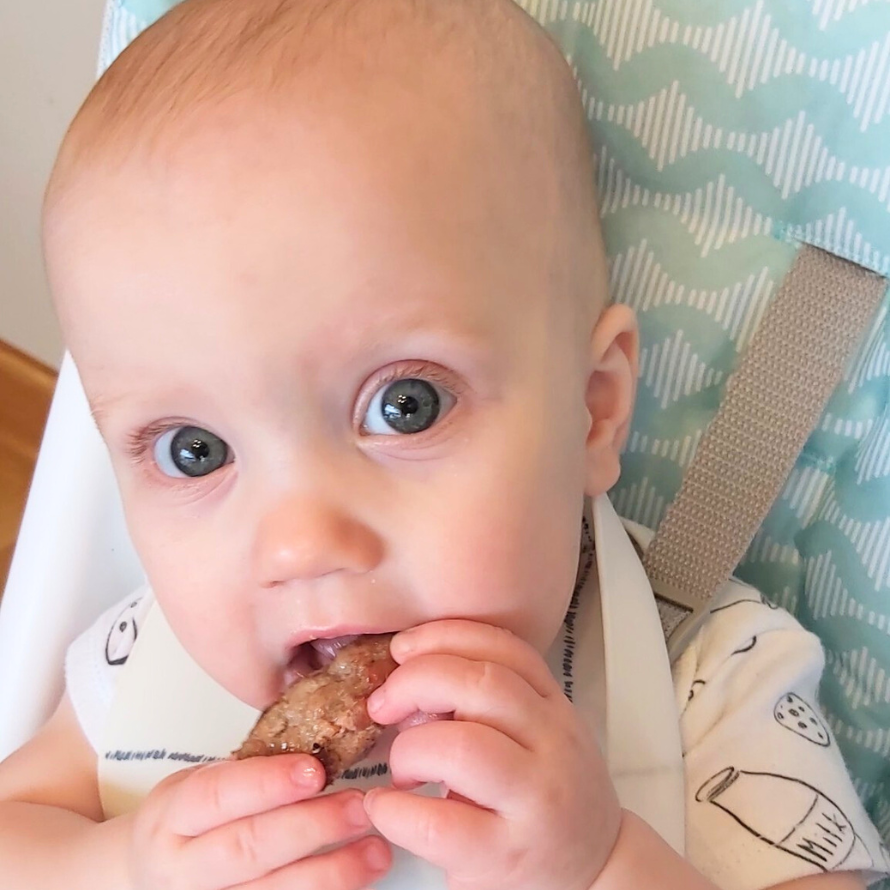






6 Comments
Can apple sauce be used? If so, does that change how much milk is needed because the apple sauce is more liquidy then just grated apples?
Thanks!
It hasn’t been tested with apple sauce, but I think it would work. And I would agree that adjusting the milk would be best or it would be too much liquid. Let us know how it turns out!
Total failure
Oh no! If you’d like to provide some more feedback about the recipe, we’d really appreciate it! Please send up an email at [email protected]
Have you frozen these after baking? Do they thaw well?
We haven’t tested this out yet, but if you do we’d love to hear how they turn out! 🙂